CHEVROLET VENTURE 1998 User Guide
Manufacturer: CHEVROLET, Model Year: 1998, Model line: VENTURE, Model: CHEVROLET VENTURE 1998Pages: 474, PDF Size: 25.26 MB
Page 11 of 474
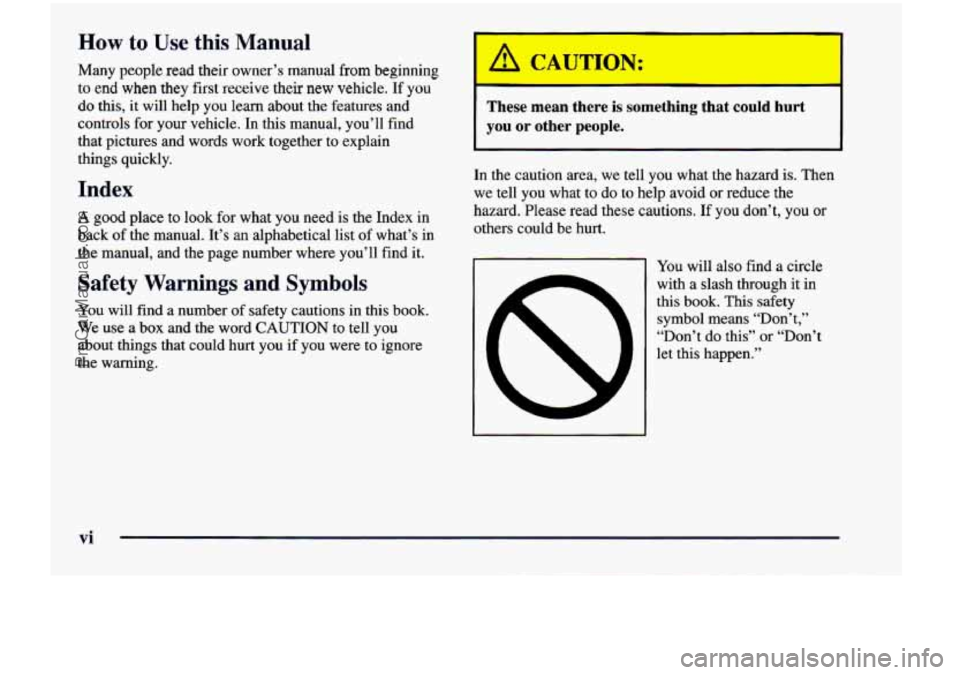
How to Use this Manual
Many people read their owner’s manual from beginning
to end
when they first receive their new vehicle. If you
do this, it will help you learn about the features and
controls for your vehicle. In this manual, you’ll find
that pictures and words work together to explain
things quickly.
Index
A good place to look for what you need is the Index in
back of the manual. It’s
an alphabetical list of what’s in
the manual, and the page number where you’ll find it.
Safety Warnings and Symbols
You will find a number of safety cautions in this book.
We use a box and the word CAUTION to tell you
about things that could hurt you if you were
to ignore
the warning.
I
These mean there is something that could hurt
you or other people.
In the caution area, we tell you what the hazard is. Then
we tell you what to do to help avoid or reduce the
hazard. Please read these cautions. If you don’t, you or
Ithers could be hurt.
You will also find a circle
with a slash through it in
this book. This safety
symbol means “Don’t,’’
“Don’t do this” or “Don’t
let this happen.”
vi
ProCarManuals.com
Page 12 of 474
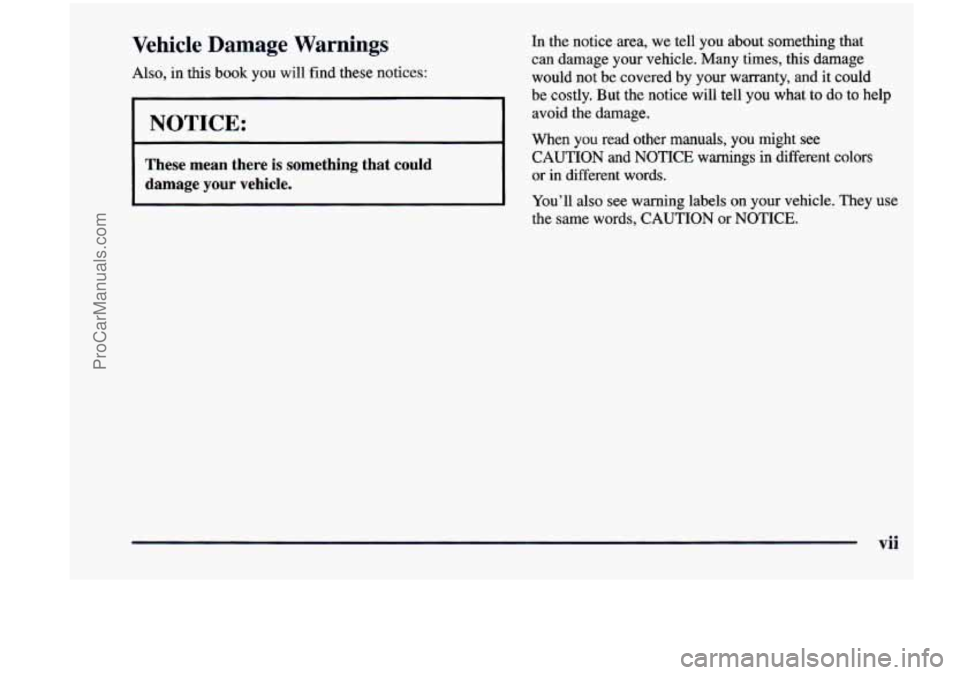
Vehicle Damage Warnings
Also, in this book you will find these notices:
NOTICE:
These mean there is something that could
damage
your vehicle.
In the notice area, we tell you about something that
can damage your vehicle. Many times, this damage
would not
be covered by your warranty, and it could
be costly. But the notice will tell you what to do to help
avoid the damage.
When you read other manuals,
you might see
CAUTION
and NOTICE warnings in different colors
or in different words.
You’ll also see warning labels on your vehicle. They use
the same words, CAUTION or NOTICE.
vii
ProCarManuals.com
Page 13 of 474
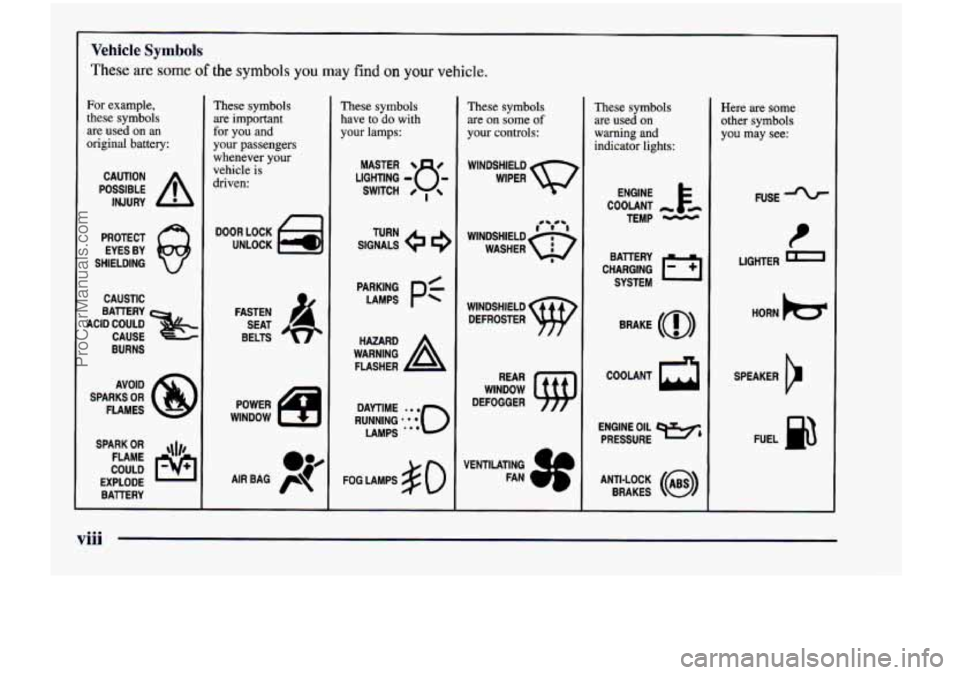
Vehicle Symbols
These are some of the symbols you may find on your vehicle.
For example,
these symbols
are used on an
original battery:
POSSIBLE A
CAUTION
INJURY
PROTECT EYES BY
SHIELDING
Q
CAUSTIC
BURNS AVOID
SPARKS
OR
FLAMES
SPARK
OR ,\I/,
COULD FLAME
EXPLODE BA'ITERY
These symbols
are important
for you and
your passengers
whenever your
vehicle is
driven:
DOOR LOCK
UNLOCK
FASTEN SEAT
BELTS
POWER
WlNDOW
These symbols
have to do with
your lamps:
SIGNALS e
TURN
FOG LAMPS
& 0
These symbols
are on some of
your controls:
WINDSHIELD WIPER
WINDSHIELD DEFROSTER
WINDOW
DEFOGGER
VENTILATING FAN
These symbols
are used on
warning and
indicator lights:
COOLANT -
TEMP -
CHARGING I-1
BAllERY
SYSTEM
BRAKE
(0)
COOLANT
a
ENGINE OIL e,
PRESSURE
ANTI-LOCK
(@)
BRAKES
Here are some
other symbols
you may see:
FUSE
LIGHTER m
HORN b
SPEAKER
cr
FUEL B
viii
ProCarManuals.com
Page 14 of 474
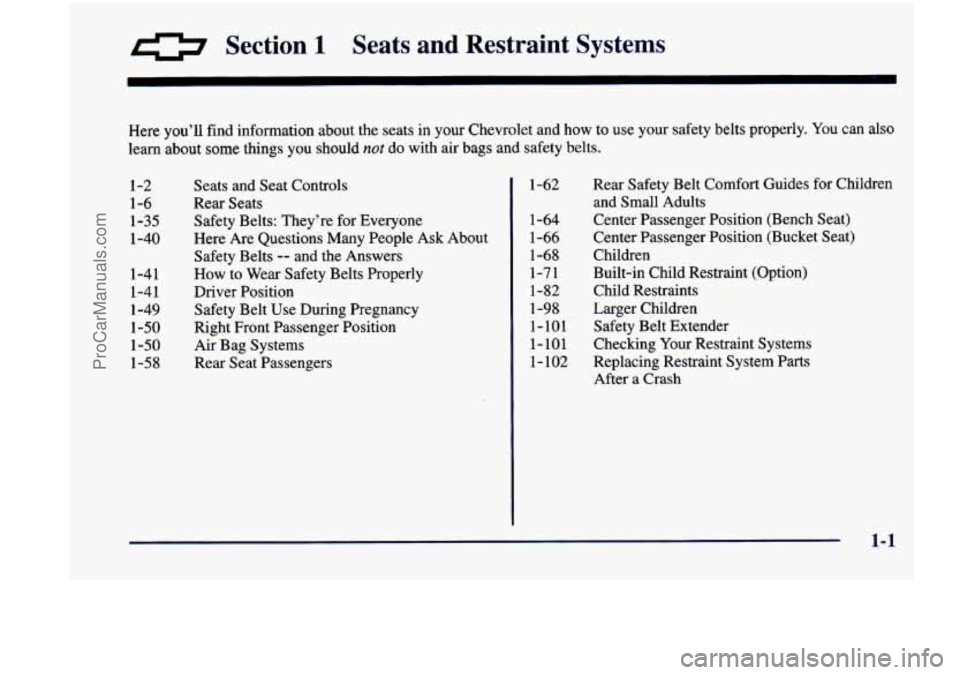
a Section 1 Seats r--Id Restraint Systems
m
Here you’ll find information about the seats in your Chevrolet and how to use your safety belts properly. You can also
learn about some things you should
not do with air bags and safety belts.
1-2
1-6
1-35
1-40
1-41 1-41
1-49 1-50
1-50
1-58 Seats and
Seat Controls
Rear Seats Safety Belts: They’re for Everyone
Here Are Questions Many People Ask About
Safety Belts
-- and the Answers
How to Wear Safety Belts Properly
Driver Position Safety Belt Use During Pregnancy
Right Front Passenger Position
Air Bag Systems
Rear Seat Passengers 1-62
1-64
1-66
1-68
1-7
1
1-82
1-98
1-101
1-101
1-102 Rear Safety Belt Comfort Guides
for Children
and Small Adults
Center Passenger Position (Bench Seat)
Center Passenger Position (Bucket Seat)
Children
Built-in Child Restraint (Option)
Child Restraints
Larger Children Safety Belt Extender
Checking
Your Restraint Systems
Replacing Restraint System
Parts
After a Crash
1-1
ProCarManuals.com
Page 15 of 474
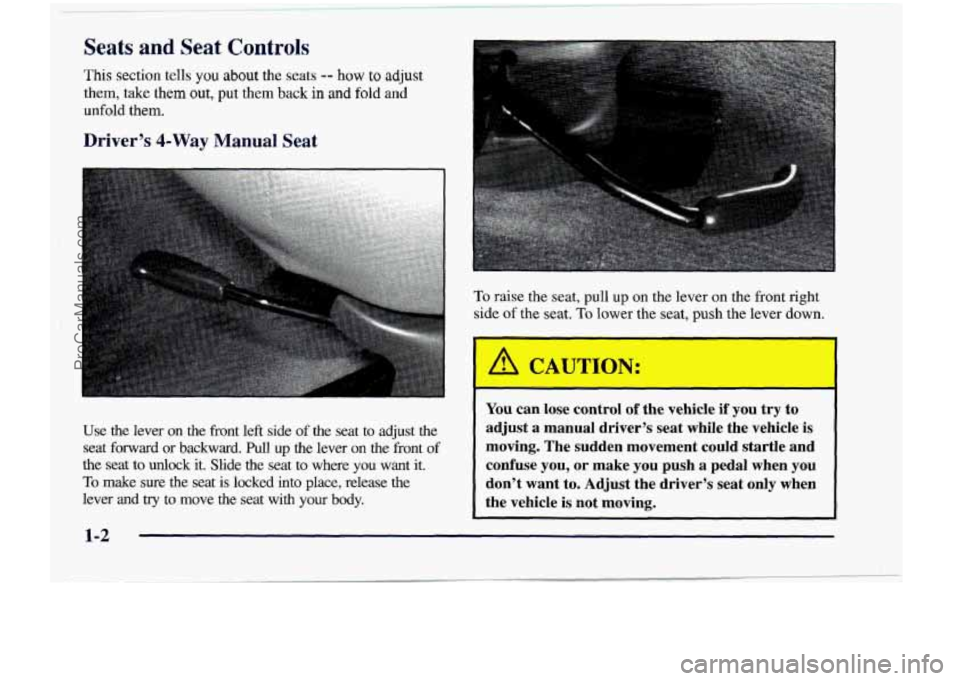
Seats and Seat Controls
This section tells you about the seats -- how to adjust
them, take them out, put them back in and fold and
unfold them.
Driver’s 4-Way Manual Seat
Use the lever on the front left side of the seat to adjust the
seat forward
or backward. Pull up the lever on the front of
the seat to unlock it. Slide the seat to where you want it.
To make sure the seat is locked into place, release the
lever and try to move the seat with your body.
1-2
To raise the seat, pull up on the lever on the front right
side
of the seat. To lower the seat, push the lever down.
You can lose control of the vehicle if you try to
adjust a manual driver’s seat while the vehicle is
moving. The sudden movement could startle and confuse you,
or make you push a pedal when you
don’t want
to. Adjust the driver’s seat only when
the vehicle is not moving.
I
ProCarManuals.com
Page 16 of 474
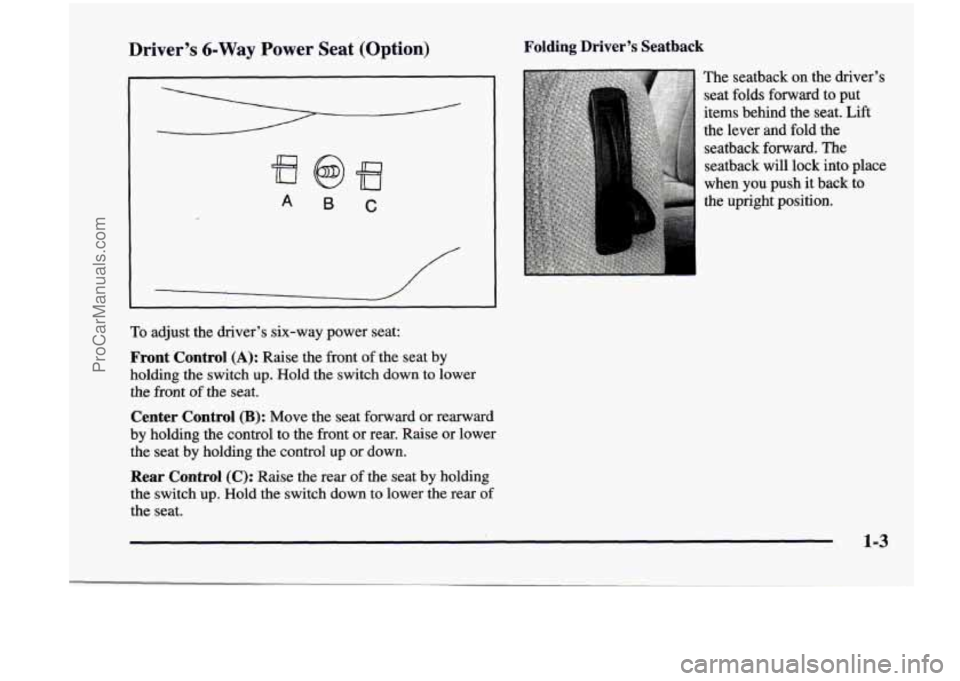
Driver’s 6-Way Power Seat (Option) Folding Driver’s Seatback
A 6 C
To adjust the driver’s six-way power seat:
Front Control (A): Raise the front of the seat by
holding the switch up. Hold the switch down
to lower
the front
of the seat.
Center Control (B): Move the seat forward or rearward
by holding the control to the front or rear. Raise or lower
the seat by holding the control up or down.
Rear Control (C): Raise the rear of the seat by holding
the switch up. Hold the switch down to lower the rear of
the seat. The seatback
on the driver’s
seat folds forward to put
items behind the seat. Lift
the lever and fold the
seatback forward. The
seatback will lock into place
when you push it back to
the upright position.
1-3
ProCarManuals.com
Page 17 of 474
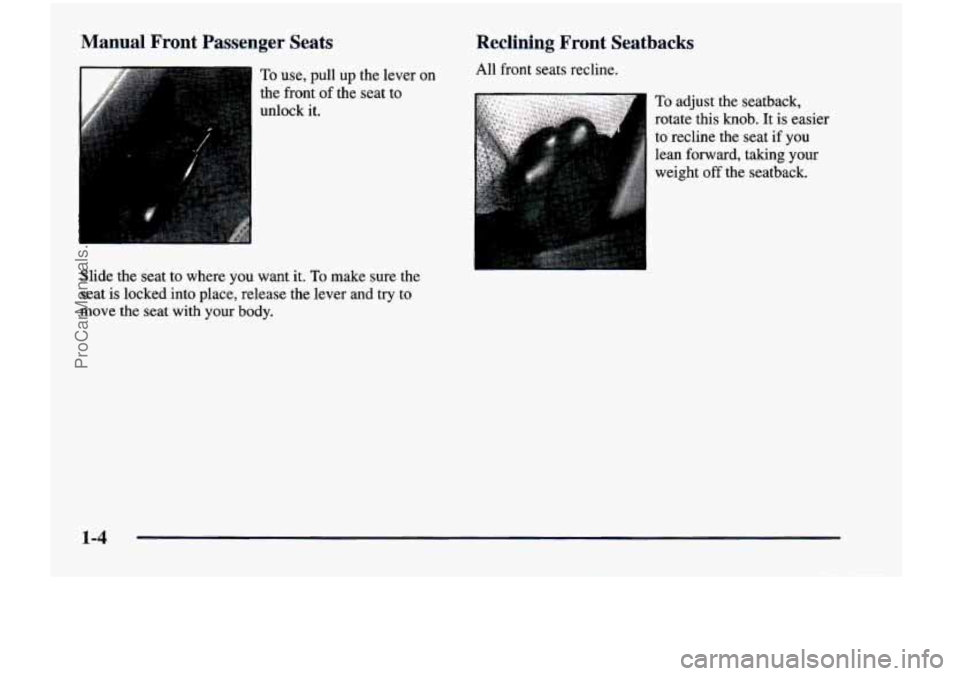
Manual Front Passenger Seats
To use, pull up the lever on
the front
of the seat to
unlock it.
Slide the seat to where you want it.
To make sure the
seat is locked into place, release the lever and try to
move the seat with your body.
Reclining Front Seatbacks
All front seats recline.
To adjust the seatback,
rotate this knob. It
is easier
to recline the seat if you
lean
forward, taking your
weight
off the seatback.
1-4
ProCarManuals.com
Page 18 of 474
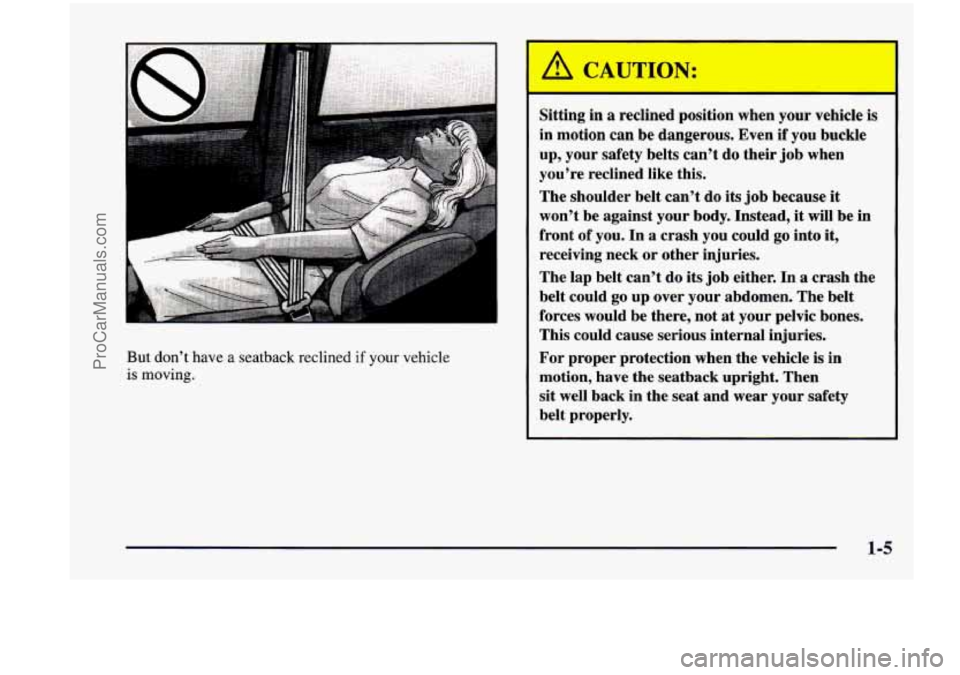
But don’t have a seatback reclined if your vehicle
is moving.
Sitting in a reclined position when your vehicle is
in motion can be dangerous. Even
if you buckle
up, your safety belts can’t
do their job when
you’re reclined like this.
The shoulder belt can’t do its job because it
won’t be against your body. Instead, it will be in
front
of you. In a crash you could go into it,
receiving neck or other injuries.
The lap belt can’t do its job either.
In a crash the
belt could
go up over your abdomen. The belt
forces would
be there, not at your pelvic bones.
This could cause serious internal injuries.
For proper protection when the vehicle
is in
motion, have the seatback upright.
Then
sit well back in the seat and wear your safety
belt properly.
1-5
ProCarManuals.com
Page 19 of 474
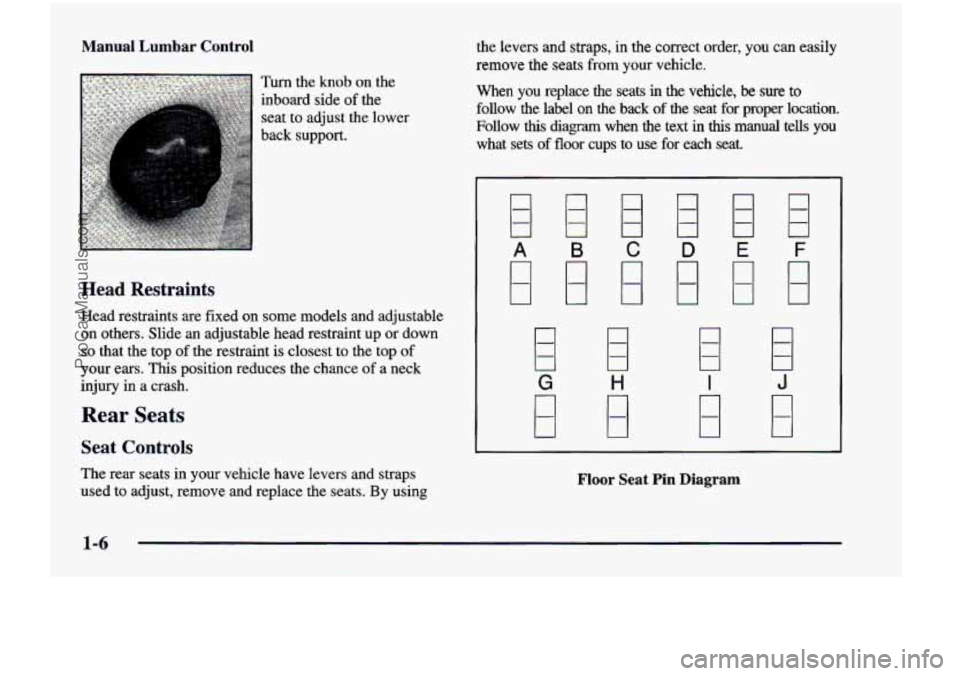
Manual Lumbar Control
Turn the knob on the
inboard side
of the
seat to adjust the lower
back support.
Head Restraints
Head restraints are fixed on some models and adjustable
on
others. Slide an adjustable head restraint up or down
so that the top of the restraint is closest to the top of
your ears. This position reduces the chance of a neck
injury in a crash.
Rear Seats
Seat Controls
The rear seats in your vehicle have levers and straps
used to adjust, remove
and replace the seats. By using the levers and straps,
in the correct order,
you can easily
remove the seats
from your vehicle.
When you replace the seats
in the vehicle, be sure to
follow the label on the back of the seat for proper location.
Follow
this diagram when the text in this manual tells you
what sets of floor cups to use
for each seat.
00
A B
0
G
FI
D
1 I
H
F
J
B
I
U
Floor Seat Pin Diagram
1-6
ProCarManuals.com
Page 20 of 474
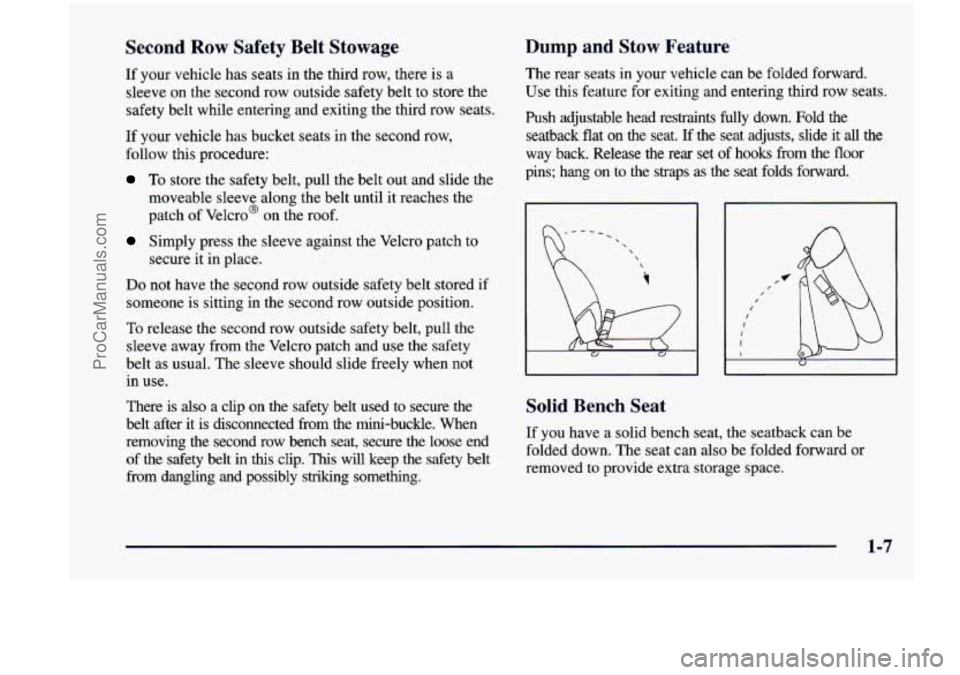
Second Row Safety Belt Stowage Dump and Stow Feature
If your vehicle has seats in the third row, there is a
sleeve
on the second row outside safety belt to store the
safety belt while entering and exiting the third
row seats.
If your vehicle has bucket seats in the second row,
follow this procedure:
To store the safety belt, pull the belt out and slide the
moveable sleeve along the belt until it reaches the
patch of Velcro@ on the roof.
Simply press the sleeve against the Velcro patch to
Do not have the second row outside safety belt stored if
someone is sitting in the second row outside position.
To release the second row outside safety belt, pull the
sleeve away from the Velcro patch and
use the safety
belt
as usual. The sleeve should slide freely when not
in use. secure it in place.
There is
also a clip on the safety belt used to secure the
belt after
it is disconnected from the mini-buckle. When
removing
the second row bench seat, secure the loose end
of the safety belt
in this clip. This will keep the safety belt
fi-om dangling and possibly striking something. The
rear seats in
your vehicle can be folded forward.
Use this feature for exiting and entering third row seats.
Push adjustable head restraints fully
down. Fold the
seatback flat on the seat.
If the seat adjusts, slide it all the
way back. Release
the rear set of hooks from the floor
pins; hang on to the straps as the seat folds forward.
I I I I I
Solid Bench Seat
If you have a solid bench seat, the seatback can be
folded down. The seat can also be folded forward or
removed
to provide extra storage space.
1-7
ProCarManuals.com